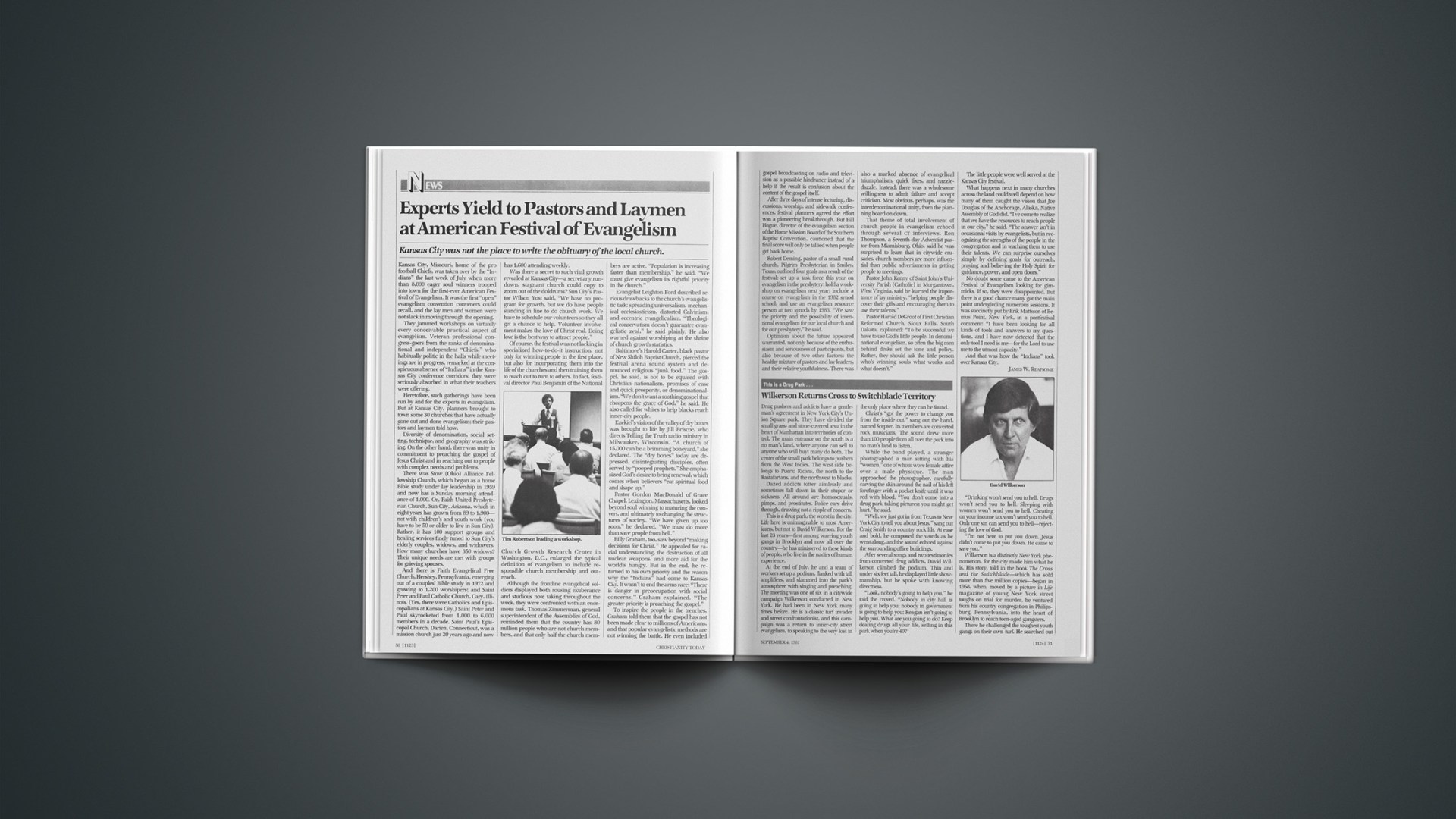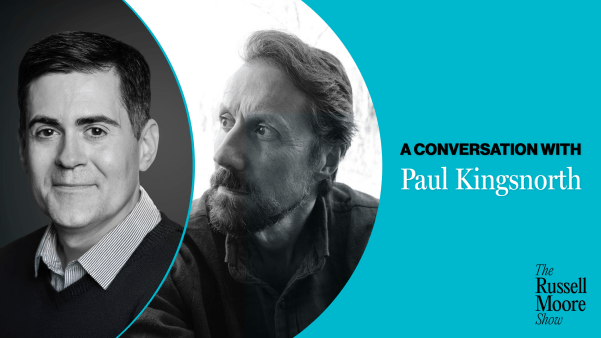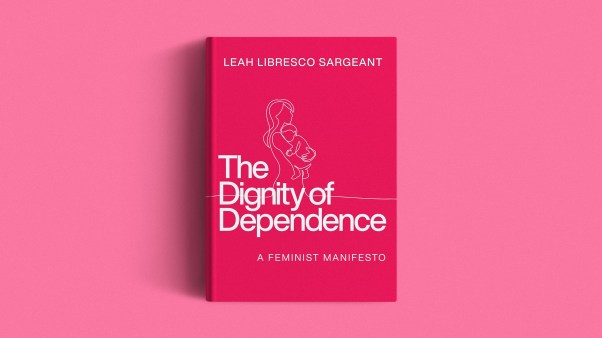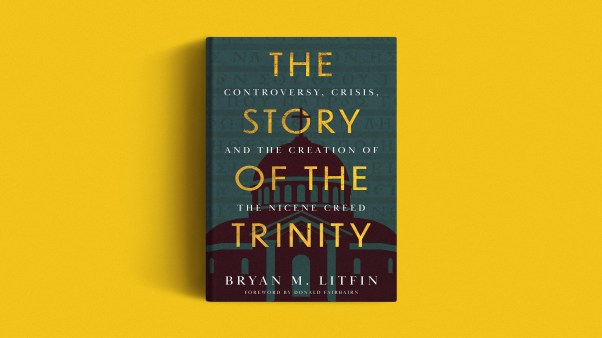Kansas City was not the place to write the obituary of the local church.
Kansas City, Missouri, home of the pro football Chiefs, was taken over by the “Indians” the last week of July when more than 8,000 eager soul winners trooped into town for the first-ever American Festival of Evangelism. It was the first “open” evangelism convention conveners could recall, and the lay men and women were not slack in moving through the opening.
They jammed workshops on virtually every conceivable practical aspect of evangelism. Veteran professional congress-goers from the ranks of denominational and independent “Chiefs,” who habitually politic in the halls while meetings are in progress, remarked at the conspicuous absence of “Indians” in the Kansas City conference corridors: they were seriously absorbed in what their teachers were offering.
Heretofore, such gatherings have been run by and for the experts in evangelism. But at Kansas City, planners brought to town some 30 churches that have actually gone out and done evangelism; their pastors and laymen told how.
Diversity of denomination, social setting, technique, and geography was striking. On the other hand, there was unity in commitment to preaching the gospel of Jesus Christ and in reaching out to people with complex needs and problems.
There was Stow (Ohio) Alliance Fellowship Church, which began as a home Bible study under lay leadership in 1959 and now has a Sunday morning attendance of 1,000. Or, Faith United Presbyterian Church, Sun City, Arizona, which in eight years has grown from 89 to 1,900—not with children’s and youth work (you have to be 50 or older to live in Sun City). Rather, it has 100 support groups and healing services finely tuned to Sun City’s elderly couples, widows, and widowers. How many churches have 350 widows? Their unique needs are met with groups for grieving spouses.
And there is Faith Evangelical Free Church, Hershey, Pennsylvania, emerging out of a couples’ Bible study in 1972 and growing to 1,200 worshipers; and Saint Peter and Paul Catholic Church, Cary, Illinois. (Yes, there were Catholics and Episcopalians at Kansas City.) Saint Peter and Paul skyrocketed from 1,000 to 6,000 members in a decade. Saint Paul’s Episcopal Church, Darien, Connecticut, was a mission church just 20 years ago and now has 1,600 attending weekly.
Was there a secret to such vital growth revealed at Kansas City—a secret any rundown, stagnant church could copy to zoom out of the doldrums? Sun City’s Pastor Wilson Yost said, “We have no program for growth, but we do have people standing in line to do church work. We have to schedule our volunteers so they all get a chance to help. Volunteer involvement makes the love of Christ real. Doing love is the best way to attract people.”
Of course, the festival was not lacking in specialized how-to-do-it instruction, not only for winning people in the first place, but also for incorporating them into the life of the churches and then training them to reach out to turn to others. In fact, festival director Paul Benjamin of the National Church Growth Research Center in Washington, D.C., enlarged the typical definition of evangelism to include responsible church membership and outreach.
Although the frontline evangelical soldiers displayed both rousing exuberance and studious note taking throughout the week, they were confronted with an enormous task. Thomas Zimmerman, general superintendent of the Assemblies of God, reminded them that the country has 80 million people who are not church members, and that only half the church members are active. “Population is increasing faster than membership,” he said. “We must give evangelism its rightful priority in the church.”
Evangelist Leighton Ford described serious drawbacks to the church’s evangelistic task: spreading universalism, mechanical ecclesiasticism, distorted Calvinism, and eccentric evangelicalism. “Theological conservatism doesn’t guarantee evangelistic zeal,” he said plainly. He also warned against worshiping at the shrine of church growth statistics.
Baltimore’s Harold Carter, black pastor of New Shiloh Baptist Church, pierced the festival arena sound system and denounced religious “junk food.” The gospel, he said, is not to be equated with Christian nationalism, promises of ease and quick prosperity, or denominationalism. “We don’t want a soothing gospel that cheapens the grace of God,” he said. He also called for whites to help blacks reach inner-city people.
Ezekiel’s vision of the valley of dry bones was brought to life by Jill Briscoe, who directs Telling the Truth radio ministry in Milwaukee, Wisconsin. “A church of 15,000 can be a brimming boneyard,” she declared. The “dry bones” today are depressed, disintegrating disciples, often served by “pooped prophets.” She emphasized God’s desire to bring renewal, which comes when believers “eat spiritual food and shape up.”
Pastor Gordon MacDonald of Grace Chapel, Lexington, Massachusetts, looked beyond soul winning to maturing the convert, and ultimately to changing the structures of society. “We have given up too soon,” he declared. “We must do more than save people from hell.”
Billy Graham, too, saw beyond “making decisions for Christ.” He appealed for racial understanding, the destruction of all nuclear weapons, and more aid for the world’s hungry. But in the end, he returned to his own priority and the reason why the “Indians” had come to Kansas City. It wasn’t to end the arms race: “There is danger in preoccupation with social concerns,” Graham explained. “The greater priority is preaching the gospel.”
To inspire the people in the trenches, Graham told them that the gospel has not been made clear to millions of Americans, and that popular evangelistic methods are not winning the battle. He even included gospel broadcasting on radio and television as a possible hindrance instead of a help if the result is confusion about the content of the gospel itself.
After three days of intense lecturing, discussions, worship, and sidewalk conferences, festival planners agreed the effort was a pioneering breakthrough. But Bill Hogue, director of the evangelism section of the Home Mission Board of the Southern Baptist Convention, cautioned that the final score will only be tallied when people get back home.
Robert Deming, pastor of a small rural church, Pilgrim Presbyterian in Smiley, Texas, outlined four goals as a result of the festival: set up a task force this year on evangelism in the presbytery; hold a workshop on evangelism next year; include a course on evangelism in the 1982 synod school; and use an evangelism resource person at two synods by 1983. “We saw the priority and the possibility of intentional evangelism for our local church and for our presbytery,” he said.
Optimism about the future appeared warranted, not only because of the enthusiasm and seriousness of participants, but also because of two other factors: the healthy mixture of pastors and lay leaders, and their relative youthfulness. There was also a marked absence of evangelical triumphalism, quick fixes, and razzle-dazzle. Instead, there was a wholesome willingness to admit failure and accept criticism. Most obvious, perhaps, was the interdenominational unity, from the planning board on down.
That theme of total involvement of church people in evangelism echoed through several CT interviews. Ron Thompson, a Seventh-day Adventist pastor from Miamisburg, Ohio, said he was surprised to learn that in citywide crusades, church members are more influential than public advertisments in getting people to meetings.
Pastor John Kenny of Saint John’s University Parish (Catholic) in Morgantown, West Virginia, said he learned the importance of lay ministry, “helping people discover their gifts and encouraging them to use their talents.”
Pastor Harold DeGroot of First Christian Reformed Church, Sioux Falls, South Dakota, explained: “To be successful we have to use God’s little people. In denominational evangelism, so often the big men behind desks set the tone and policy. Rather, they should ask the little person who’s winning souls what works and what doesn’t.”
The little people were well served at the Kansas City festival.
What happens next in many churches across the land could well depend on how many of them caught the vision that Joe Douglas of the Anchorage, Alaska, Native Assembly of God did. “I’ve come to realize that we have the resources to reach people in our city,” he said. “The answer isn’t in occasional visits by evangelists, but in recognizing the strengths of the people in the congregation and in teaching them to use their talents. We can surprise ourselves simply by defining goals for outreach, praying and believing the Holy Spirit for guidance, power, and open doors.”
No doubt some came to the American Festival of Evangelism looking for gimmicks. If so, they were disappointed. But there is a good chance many got the main point undergirding numerous sessions. It was succinctly put by Erik Mattsson of Bemus Point, New York, in a postfestival comment: “I have been looking for all kinds of tools and answers to my questions, and I have now detected that the only tool I need is me—for the Lord to use me to the utmost capacity.”
And that was how the “Indians” took over Kansas City.
This Is a Drug Park …
Wilkerson Returns Cross To Switchblade Territory
Drug pushers and addicts have a gentleman’s agreement in New York City’s Union Square park. They have divided the small grass- and stone-covered area in the heart of Manhattan into territories of control. The main entrance on the south is a no man’s land, where anyone can sell to anyone who will buy; many do both. The center of the small park belongs to pushers from the West Indies. The west side belongs to Puerto Ricans, the north to the Rastafarians, and the northwest to blacks.
Dazed addicts totter aimlessly and sometimes fall down in their stupor or sickness. All around are homosexuals, pimps, and prostitutes. Police cars drive through, drawing not a ripple of concern.
This is a drug park, the worst in the city. Life here is unimaginable to most Americans, but not to David Wilkerson. For the last 23 years—first among warring youth gangs in Brooklyn and now all over the country—he has ministered to these kinds of people, who live in the nadirs of human experience.
At the end of July, he and a team of workers set up a podium, flanked with tall amplifiers, and slammed into the park’s atmosphere with singing and preaching. The meeting was one of six in a citywide campaign Wilkerson conducted in New York. He had been in New York many times before. He is a classic turf invader and street confrontationist, and this campaign was a return to inner-city street evangelism, to speaking to the very lost in the only place where they can be found.
Christ’s “got the power to change you from the inside out,” sang out the band, named Scepter. Its members are converted rock musicians. The sound drew more than 100 people from all over the park into no man’s land to listen.
While the band played, a stranger photographed a man sitting with his “women,” one of whom wore female attire over a male physique. The man approached the photographer, carefully carving the skin around the nail of his left forefinger with a pocket knife until it was red with blood. “You don’t come into a drug park taking pictures; you might get hurt.” he said.
“Well, we just got in from Texas to New York City to tell you about Jesus,” sang out Craig Smith to a country rock lilt. At ease and bold, he composed the words as he went along, and the sound echoed against the surrounding office buildings.
After several songs and two testimonies from converted drug addicts, David Wilkerson climbed the podium. Thin and under six feet tall, he displayed little showmanship, but he spoke with knowing directness.
“Look, nobody’s going to help you,” he told the crowd. “Nobody in city hall is going to help you; nobody in government is going to help you; Reagan isn’t going to help you. What are you going to do? Keep dealing drugs all your life, selling in this park when you’re 40?
“Drinking won’t send you to hell. Drugs won’t send you to hell. Sleeping with women won’t send you to hell. Cheating on your income tax won’t send you to hell. Only one sin can send you to hell—rejecting the love of God.
“I’m not here to put you down. Jesus didn’t come to put you down. He came to save you.”
Wilkerson is a distinctly New York phenomenon, for the city made him what he is. His story, told in the book The Cross and the Switchblade—which has sold more than five million copies—began in 1958, when, moved by a picture in Life magazine of young New York street toughs on trial for murder, he ventured from his country congregation in Philipsburg, Pennsylvania, into the heart of Brooklyn to reach teen-aged gangsters.
There he challenged the toughest youth gangs on their own turf. He searched out the Mau Maus, known as the meanest gang in the city. “I told Nickie Cruz, a leader of the Mau Maus, ‘God loves you.’ He spit on me and told me to go to hell,” Wilkerson recalled. Soon Cruz was converted and became an evangelist himself.
So that addicts could have a place to kick drugs and start a new life, Wilkerson founded the Teen Challenge center in Brooklyn. According to a 1975 federal study, the center has a better cure rate than any other drug treatment program in the country. He has founded similar programs in other cities.
Expanding his ministry, Wilkerson then bought a 350-acre, $5 million ranch in Texas, moved out of New York, and started a school. It was a life’s dream, he said.
But nine months ago he abandoned the dream and changed directions. He sold the ranch to Youth With a Mission, moved his headquarters to a house on a small Texas farm with a metal warehouse for storing his books and tracts, and returned to street evangelism. He went first to San Francisco, then New York.
“I got tired of preaching to the goody-goodies and smuggies,” he said.
In the next three years he plans to hold campaigns like the one in New York in the nation’s 10 largest cities. “Getting back to roots,” is how he described it.
There is hope for America’s cities, Wilkerson says, but that hope is in doing things this way, getting right down to the “nitty gritty.”
The campaign in New York began early in July with young people handing out a nicely printed tract titled “Rock Bottom” all around the area. By the end of the month they had passed out more than a million tracts in Brooklyn, Queens, Manhattan, Staten Island, and the Bronx. The campaign cost $225,000.
“I’m terribly alarmed at what I’ve seen this year,” Wilkerson said. “The only word I can use to explain it is ‘demonic.’ In Manhattan, I have yet to find any teen-ager to have any time in his life for God at all. It’s paganism.
“There is such apathy. God just does not figure in their pleasure madness.”
Talking to students in Washington Park in lower Manhattan right beside New York University, he said he heard a new term—the “80-year-bang,” defined this way: “God gives you 80 years to turn on.”
Wilkerson said he found he needed a different “key” in New York for each street meeting in order to break past the apathy. In Spanish Harlem, the key was drugs and children. Nothing seemed to get through until he asked mothers to come forward for prayer to keep their children off drugs, which are as available in the schools as in the streets. In Union Square, the key was methadone, Wilkerson said. “When I started talking about ‘meth,’ they knew I knew what I was talking about.”
Methadone is a synthetic drug often used in treatment programs to block the effects of heroin. But it, too, is addictive. Many addicts mix methadone, heroin, and alcohol. “We can take a heroin addict off cold turkey, but it’s very, very dangerous to take a meth addict off cold turkey,” he said.
In Union Square, Wilkerson talked about the pain methadone brings. “Your bones ache. You can’t sleep at night. Coming to Jesus Christ not only breaks your habit, it gives you a new mind and spirit and a renewed body.” Then he called people to come forward out of no man’s land onto the grass in front of the podium. A tall black man immediately responded, then a score more. “I want 25 more of you to come forward,” he called out with an authority that seemed to compel an answer. Some were in drug fogs, some homosexuals. Among them stood the person with the female attire on a male physique.
EDMUND K. GRAVELY, JR.
Western Canada
The Thinking Person’S Evangelist: Terry Winter
One Saturday not long ago, a Vancouver (British Columbia) newspaper did a one-page “exposé” of television evangelists, citing their multimillion-dollar budgets.
On the following Monday, Jack Webster, a colorful Scottish-born television call-in host, met Vancouver evangelist Teny Winter at the television studio they share and offered to buy him a cup of coffee. Webster volunteered the tongue-in-cheek comment that Winter had not yet discovered the pot of gold at the end of the religious rainbow. After all, he suggested, what is an annual budget of $222,000 against the millions those big-time Americans were allegedly siphoning off.
Winter’s encounter with Webster was symbolic of the 38-year-old evangelist’s style of ministry. His name is not quite a household word, even in western Canada where his work in Christian communication has been receiving increasing recognition for more than a decade. Yet the ratings show that in B.C., for example almost as many people watch Winter on television on Sunday afternoons as watch golf. More significant, perhaps, is the fact that four to five times as many young people set the channel selector on Winter as on the fairway.
His half-hour television show covers the populated areas of Canada’s four western provinces. A pilot project was started in Ontario in 1979, and he will be holding evangelistic meetings in Barry, Ontario, this fall to test his drawing power there. The project’s continuation hinges on whether financial support can be built in a part of Canada with which Winter has not been identified.
He is sometimes called a “thinking person’s evangelist” by those who prefer to keep evangelism at arm’s length. The assessment is correct, but not because Winter considers some people to be thinkers and others not. His view is that people are, first of all, intelligent beings who are as ready to respond to reason as to any other stimuli.
With an earned doctorate from Fuller Theological Seminary, Winter embarked on his evangelism work 11 years ago. He worked from a base about 10 minutes’ drive from where Regent College began at about the same time. The college is a completely separate organization from Terry Winter Christian Communication (TWCC), but informal links are visible to the observer. Their respective roots are planted in soil cultivated by key people in the Christian (Plymouth) Brethren movement. In the late 1960s, a number of Brethren lay leaders in the Vancouver area, stimulated by such British compatriots as F. F. Bruce, began looking for imaginative ways to communicate intelligently the Christian faith. Regent became the educational vehicle; Terry Winter was there at the right time to develop an evangelism thrust.
Today, Regent and TWCC are both much broader based than their original roots. Both, however, retain their initial emphases on the need for lay people to be thoughtful students and communicators of the gospel.
Anglican in background, as is his wife, Joan, Winter made his own Christian commitment as a high school student on Vancouver Island. His conversion was triggered by the preaching of British Brethren evangelist Stan Ford—and the personal invitation of a fellow high school student. Headed for medical school at the University of British Columbia, Winter altered his career path when he discovered his ability to explain the Christian faith to others. Even today, he would rather be described as an explainer or communicator than as an evangelist or preacher.
Winter met his wife, a former UBC gold medalist in pharmacy, when she attended an Inter-Varsity Christian Fellowship meeting he was leading. A few coffee breaks and serious discussions later and Joan had sharpened her commitment both to the Christian faith and to her future husband. They have four children, including twins.
The format of Winter’s television show is simple. Musicians key the Christian message to a theme for the day. Someone—often a young person—tells about how he or she became a Christian, setting the scene for a clear-cut explanation of the gospel, which is frequently set in interview format involving well-reputed Christian scholars in the discussion. British Anglican Michael Green was featured last fall in a special six-part series. And Roy Bell, vice-president of the Baptist World Alliance and principal of Carey Hall, is a frequent guest.
Winter always concludes the show with the recurring theme: “What will you do with the claims of Christ?”
The television program grew out of Winter’s crusades. He continues to visit about a half-dozen western Canadian cities a year—most recently Brandon, Manitoba, and Kelowna and Chilliwack, B.C. While most of the cities are small—under 50,000 in population—Winter has ministered in places such as Victoria and Calgary, with census figures of 200,000 and 600,000 respectively. His latest large crusade, Regina Alive, was held in May 1980 in Saskatchewan’s capital city.
Winter finds planning for smaller and larger centers quite different. The community spirit in smaller centers, for example, often helps the word spread faster. The closing night crowd in the northern port city of Prince Rupert (population 15,000) was 700. Regina, 10 times the size, drew 2,200 on closing night. He generally draws involvement from churches all along the Christian spectrum.
Although the “Alive” crusades have the earmarks of evangelism—the crowds, the music, and the invitations (complete with singing “Just As I Am”)—Winter tries to steer away from the term “mass evangelism.” To him, the task is one of personal evangelism multiplied hundreds of times over. Precrusade “Christians Alive” sessions attempt to build that concept through the mobilization of the Christian community.
He tries, too, to avoid the money hangup. He shies away from empire building, attempting to operate with a small, tightly knit organization able to stand close scrutiny. His own salary is pegged to current B.C. rates for teachers with 10 years experience.
His team members are young westerners: a classical piano duo consisting of brothers Mel and Holden Bowker and folk-singers Roy Salmond and Mike Mulder. Other team members, notably Vancouver developer Ken Smith, work in the biblical tradition of “tentmaking,” earning their livings in the secular world and participating in the crusades at vacation time. Smith is the songleader and handles much of the behind-the-scenes organization. Accountant Peter Karios is the organization’s treasurer and handles photography during some of the crusades.
The relatively small population of western Canada (six million people spread over one million square miles) dictates that Winter’s organization will need to stay tightly knit to remain effective. He is comfortable with the idea, however, having been influenced in recent years by some of the concepts developed in Schumacher’s book, Small Is Beautiful. He believes there is a continuing niche for his style of Christian communication and a need for some evangelists to develop ministries that are regional in scope, rather than continental or worldwide.
LLOYD MACKEY
ACLU Suea State of Arkansas
Creation-Teaching Law Will Be Tested In Court
Some of the nation’s most qualified proponents of scientific creationism want to help fight a lawsuit that seeks to throw out the recent Arkansas law requiring creationism to be taught alongside evolution in the state’s public schools. It is questionable, however, whether the creationists will be allowed to help.
The suit against creationism was filed by the American Civil Liberties Union (ACLU). Since it was filed against the state, Arkansas Attorney General Steve Clark will defend the law, and he has told the creationists he does not want outside help. The creationists, who have organized the Creation Science Legal Defense Fund, are troubled because they are not convinced that Clark fully agrees with the new law, which was passed by the Arkansas legislature earlier this year.
The Creation Science Legal Defense Fund is located in Little Rock, and its president is Carl A. Hunt. Its board of reference includes several people well-known in the creationist movement: George F. Howe, a botanist and president of the 700-member Creation Research Society; Henry M. Morris Jr., a hydraulic engineer and director of the Institute for Creation Research; William M. Overn, associate director of the Bible-Science Association; Paul D. Ackerman, a psychologist and president of the Creation Social Science and Humanities Society; A. E. Wilder-Smith, a chemist with three earned Ph.D. degrees; Walter E. Lammerts, a geneticist; Bolton David-heiser, a zoologist; Duane T. Gish, a biochemist; Harold Coffin, a paleontologist; and Bert Thompson, a food microbiologist.
Arkansas was the first state to require elementary and secondary science classes to give, in the bill’s words, “balanced treatment to creation science and evolution science.” The Louisiana State Legislature passed a creationism law in July.
The ACLU said it would oppose the attempt by the creationists to intervene in the Arkansas case. The federal judge who will try the suit has already turned down a request from a group of Unitarians to file a friend of the court brief stating their beliefs about the law.
One of the lawyers for the Creation Science Legal Defense Fund is John Whitehead. He has written several books and lectured widely on First Amendment issues, and has won several notable cases, including one in San Francisco involving a church that was sued when it fired its homosexual organist. The other lawyer for the group is Wendell Bird, general counsel for the Institute for Creation Research. He is the author of articles on First Amendment religious issues that have appeared in the Yale Law Journal and the Harvard Journal of Law and Public Policy.
The ACLU opposes the creationism law because it sees the law as a violation of the principles of church-state separation and academic freedom. The creationists say that creation science is as scientific and nonreligious as evolution science, and that academic freedom actually is abridged by indoctrinating students in evolution.
State Senator James Hoisted of North Little Rock sponsored the creationism bill and said he welcomes the suit. A Methodist, he told a Methodist newspaper he is “confident the law will stand up, but if it is not constitutional, it should be struck down.”
Others in Holsted’s denomination are not as convinced about the law as he is. A Methodist bishop, Kenneth Hicks, and four Methodist ministers are among the plaintiffs who filed suit against the law. Hicks has expressed concern about the issue of church-state separation, and one of the ministers, Jerry Canada, said, “The assumption behind creation theory, that creation came suddenly from nothing, is that there is a creator. That is religious belief, but not good science.”
The lawsuit is scheduled for trial late in October, but could be postponed. If the creationists are permitted to intervene in the case, it is possible that the merits of creationism could be presented in court full-force against evolution. That would make the case much more significant than the one in California last March. Reporters who covered that trial predicted it would become another Scopes monkey trial. But the creationists, who sought in court to prevent elementary science books from presenting a dogmatic view favoring evolution, did not press for the teaching of creationism. The principals in that case were members of the Segraves family of San Diego, who direct the Creation Science Research Center. They are not among the creationists who are trying to intervene in the Arkansas dispute.
Dungeons and Dragons
D & D: A Fantasy Fad Or Dabbling In The Demonic?
• A game like Monopoly;
• A mind-expanding substitute for television;
• Creative enactment of Tolkien fantasy;
or
• A dangerous dabble with the occult;
• Obsessive escape from reality;
• An expensive waste of time.
However you define it, Dungeons and Dragons (D & D), a complex role-playing game manufactured by TSR Hobbies of Lake Geneva, Wisconsin, has grossed millions of dollars since its inception in 1974. It has become the favorite pastime of more than three million children and adults.
It has also generated a barrage of criticism from evangelicals. One group forced the game out of the summer recreational program of a Sacramento suburb. A minister in Hutchinson, Kansas, said he wanted to collect money to buy up and burn every copy he could find of D & D.
What is this game that reaps dollars and censure?
D & D, combination fantasy trip, war-game exercise, drama workshop, and psychological act-out session, does not look like most “age-12-to-adult” games. Its cellophane wrapper does not reveal the usual game contents of board, player pieces, or printed cards. Instead, a $10 basic D & D set consists of two booklets, which barely get a player started. Really to play the game, one needs at least four more books: Player’s Handbook, Dungeon Master’s Guide, Monster Manual, and Deities and Demigods. Each ranges in price from $11 to $15.
This game does not play like most games, either. It is open-ended. Unless a player is retired or destroyed, the game can last indefinitely. One player, appointed Dungeon Master, controls play by making up maps that include traps, treasure, monsters, and magical devices. Other players assume characters like druids, thieves, clerics, magic users, or elves. Each possesses special abilities. With a toss of dice, these are assigned strengths and weaknesses in such attributes as intelligence, wisdom, strength, dexterity, and charisma. The object of the game is for players to band together to fight through a monster-laden maze of tunnels and dungeons in order to grab as much treasure as they can.
Opponents of the game say it encourages sex and violence, quoting from articles like Psychology Today’s recent “Confessions of a Dungeon Master,” by physician and D & D player John Holmes. He writes, “The level of violence in this make-believe world [of D & D] runs high. There is hardly a game in which the players do not indulge in murder, arson, torture, rape, or highway robbery.”
Some evangelicals are disturbed by D & D’s bizarre cast-list of characters, which includes demons, dragons, witches, zombies, harpies, gnomes, and creatures who cast spells and exercise supernatural powers. They say D & D dabbles with demonic spirits and promotes the influence of the occult.
Others charge D & D with role playing that becomes an obsessive retreat from the real world. One D & D player has said, “The more I play D & D, the more I want to get away from this world. The whole thing is getting very bad.”
Still others bemoan the expense of playing D & D. Besides manuals and basic instruction sets, players can invest up to $900 in hand-painted miniatures in medieval costumes with rattan replicas of ancient weaponry, 20 different modules that map out adventures, “hex” pads for recording journeys, or even a subscription to the $2 monthly, Dragon, published by D & D inventor Gary Gygax.
And excerpts from the encyclopedia-like D & D volumes themselves raise serious doubts. From Deities and Demigods: “No fantasy world is complete without the gods, mighty deities who influence the fates of men and move mortals about like chess-pieces in their obscure games of power. Such figures can be perfect embodiments of the Dungeon Master’s control of the game.”
Or this: “Serving a deity is a significant part of D & D, and all player characters should have a patron god. Alignment assumes its full importance when tied to the worship of a deity.” Players may choose “patrons” from a rich assortment of deities or “demigods”: from Egypt’s pantheon Ra (sun god), Osiris (god of nature and the dead), or Isis (goddess of magic and fertility). Or from India, Vishnu (god of mercy and light) or Varuna (god of order and protector of oaths). Gods from Babylonia, the American Indians, the Norse, or even nonhuman deities like elves, lizard men, ogres, satyrs, goblins, or gnomes are all included as possibilities.
The Players Handbook reminds players that “swords and sorcery best describe what this game is all about.” Although the game is make-believe, the Handbook also says “it is so interesting, so challenging, so mind-unleashing that it comes near reality.”
But a TSR Hobbies spokesman, Bryon Pritzer, thinks criticism of D & D is absurd. “D & D is a game,” he insists. “Sure, it can be abused—like any other game. You would complain if your child spent too much time playing Monopoly, too. We always recommend that kids finish homework before playing D & D.”
“The problem with D & D critics,” he explained, is that “they don’t understand the game. They just leaf through a manual or two, see a few demons or gods, and react. If they would just watch someone play, or play the game themselves, they would see how harmless it really is.
“Actually, the game has more benefits than dangers,” Pritzer said. D & D is used by educators, psychiatrists, and even ministers to help children. “It’s a great tool for working out problems in role-play which can later be applied to real life. D & D’s classic struggle of good versus evil could even be used to teach religion.”
But what if the Dungeon Master, who “sets the boundaries of the universe” for every D & D player, is evil? Pritcher answered, “I suppose that could happen, but it really isn’t likely. The purpose of the Dungeon Master is to be neutral, strictly neutral. The only real requirement is that he produce the most colorful, fanciful game possible.”
Here is something for today: a game that takes lots of time, accumulates status with each $12 addition, mixes demons, demigods, dragons, and monsters in violent encounters, makes a fad of fantasy—all in a world created by a “strictly neutral” Dungeon Master.
Who could possibly oppose such a game but a bunch of Christians?
PHYLLIS TEN ELSHOF










